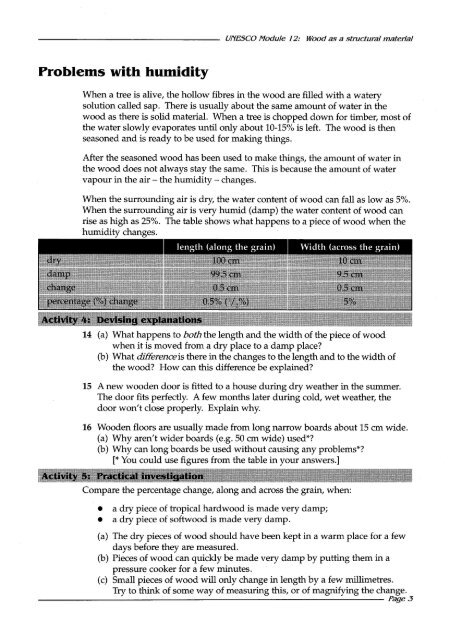UNESCO resource kit - science and technology educa...
UNESCO resource kit - science and technology educa...
UNESCO resource kit - science and technology educa...
Create successful ePaper yourself
Turn your PDF publications into a flip-book with our unique Google optimized e-Paper software.
Problems with humidity<br />
<strong>UNESCO</strong> Module 12: Wood as a structural material<br />
When a tree is alive, the hollow fibres in the wood are filled with a watery<br />
solution called sap. There is usually about the same amount of water in the<br />
wood as there is solid material. When a tree is chopped down for timber, most of<br />
the water slowly evaporates until only about 10-15% is left. The wood is then<br />
seasoned <strong>and</strong> is ready to be used for making things.<br />
After the seasoned wood has been used to make things, the amount of water in<br />
the wood does not always stay the same. This is because the amount of water<br />
vapour in the air - the humidity - changes.<br />
When the surrounding air is dry, the water content of wood can fall as low as 5%.<br />
When the surrounding air is very humid (damp) the water content of wood can<br />
rise as high as 25%. The table shows what happens to a piece of wood when the<br />
humidity changes.<br />
14 (a) What happens to both the length <strong>and</strong> the width of the piece of wood<br />
when it is moved from a dry place to a damp place?<br />
(b) What, difference is there in the changes to the length <strong>and</strong> to the width of<br />
the wood? How can this difference be explained?<br />
15 A new wooden door is fitted to a house during dry weather in the summer.<br />
The door fits perfectly. A few months later during cold, wet weather, the<br />
door won't close properly. Explain why.<br />
16 Wooden floors are usually made from long narrow boards about 15 cm wide.<br />
(a) Why aren't wider boards (e.g. 50 cm wide) used"?<br />
(b) Why can long boards be used without causing any problems*?<br />
[*You could use figures from the table in your answers.]<br />
Compare the percentage change, along <strong>and</strong> across the grain, when:<br />
• a dry piece of tropical hardwood is made very damp;<br />
• a dry piece of softwood is made very damp.<br />
(a) The dry pieces of wood should have been kept in a warm place for a few<br />
daysbefore they are measured.<br />
(b) Pieces of wood can quickly be made very damp by putting them in a<br />
pressure cooker for a few minutes.<br />
(c) Small pieces of wood will only change in length by a few millimetres.<br />
Try to think of some way of measuring this, or of magnifying the change.<br />
------------------------------------------------------------------- Page 3

















